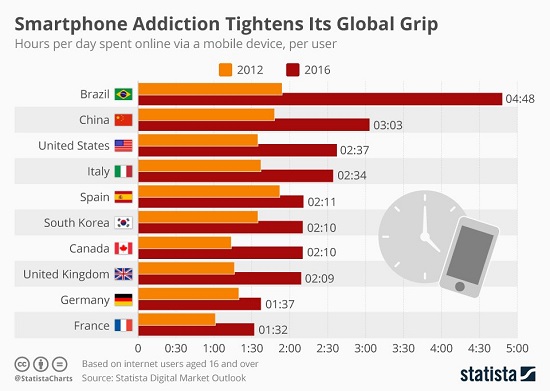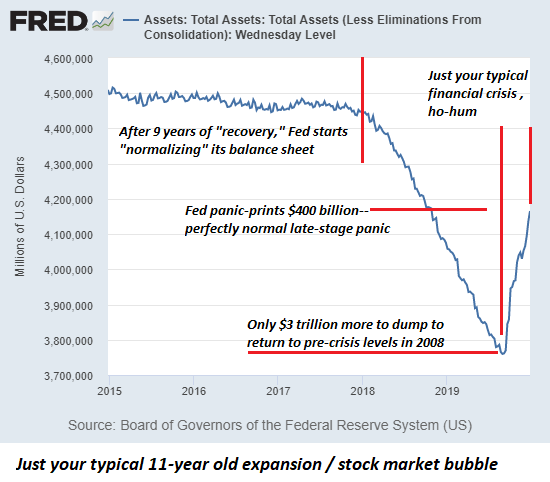If we set out to design a highly addictive platform that optimized the most toxic, destructive aspects of human nature, we'd eventually come up with social media.
Social problems arise when initially harmless addictions explode in popularity, and economic problems arise when the long-term costs of the addictions start adding up. Political problems arise when the addictions are so immensely profitable that the companies skimming the profits can buy political influence to protect their toxic products from scrutiny and regulation.
That describes both the tobacco industry before its political protection was stripped away and social media today, as the social media giants hasten to buy political influence to protect their immensely profitable monopolies from scrutiny and regulation.
It's difficult to measure the full costs of addictions because our system focuses on price discovery at the point of purchase, meaning that absent any regulatory measuring of long-term consequences, the cost of a pack of cigarettes is based not on the long-term costs but solely on the cost of producing and packaging the tobacco into cigarettes, and the enterprise side: marketing, overhead and profit.
To take tobacco as an example, the full costs of smoking two packs of cigarettes a day for 20 years is not limited to the cost of the cigarettes: 365 days/year X 20 years X 2 packs (14,600) X cost per pack ($5 each) $73,000.
The full costs might total over $1 million in treatments for lung cancer and heart disease, and the reduction in life span and productivity of the smoker. (The emotional losses of those who lose a loved one to a painful early death is difficult to assign an economic value but it is very real.)
If the full costs of the nicotine addiction were included at the point of purchase, each pack of cigarettes would cost about $70 ($1,000,000 / 14,600). Very few people could afford a habit that costs $140 per day ($51,000 per year).
What are the full costs of the current addiction to social media? These costs are even more difficult to measure than the consequences of widespread addiction to nicotine, but they exist regardless of our unwillingness or inability to measure the costs.
Consider the devastating consequences of social media on teen suicides. Here is one such story:
Tragedy.
Then there's all the lost productivity as social media addicts check their phones 150+ times a day, interrupting not just work or school but intimacy, up to and including sex.
The psychological attraction of smoking is the core of tobacco marketing, of course; no tobacco company sells cigarettes on the benefits of nicotine addiction. The pitch is that smoking cigarettes is glamorous and attractive because it's "adult" and forbidden.
Anything that has the double allure of the forbidden and the glamorous is extremely compelling to social animals such as humans, who seek to "stand out" via glamour and risk-taking to heighten our social status, which plays such a life-changing role in the selection of mates and our position in the pecking-order hierarchy.
Social media shares certain aspects of these dynamics. While it's not exactly glamorous, social media enables otherwise average individuals the golden opportunity to "stand out" and raise their social status by attracting more "likes" and positive feedback than other consumers of social media.
In effect, social media offers an extremely compelling megaphone to individuals whose social status in the real world is modest (due to the "long-tail" distribution of opportunities to become socially prominent or wealthy, which are increasingly concentrated in the very tip-top of the social hierarchy) to increase their social status in the digital realm via social media.
Compare the ease of social media to the traditional paths to social prominence: building a business or career to attain wealth, community service via leadership roles in organizations, gaining high visibility in conventional media via extraordinary good looks, athletic or artistic talent, etc. Each of these is an extremely demanding path, one that few people attain, and hence the relatively few at the top of the heap.
As my friend GFB once remarked, in the real world you have to actually earn the money to buy the Mercedes to show off to your friends, but in social media, you only need to post photos of yourself in a Mercedes in a well-chosen setting, and then relentlessly promote yourself on social media platforms.
In other words, social media holds out the promise that an average person can become larger than they are in real life with relatively modest tools (an Internet connection and a camera).
This is reinforced when we look at many of the individuals who have built huge social media audiences and find that they're not any better looking or more talented than the rest of us.
This promise of attaining higher social status without having to work incredibly hard at difficult accomplishments is very compelling.
With the rise of social media influencers as key marketing assets, the most successful social media mavens can earn extraordinary incomes by selling products to their social media audience.
Alas, the long-tail distribution of real-world social status (the few at the top garner the vast majority of the wealth and status) also applies to social media, where a relative few gain audiences in the millions and the vast majority of participants must make do with a relative handful of followers and "likes."
This leaves the majority of users extremely vulnerable to slight changes in their social media visibility and status; someone with 15 followers is devastated by the loss of 5 followers, where the individual with 6 million followers would have to lose 2 million followers to suffer the same erosion.
Toxic critics have limited opportunities in the real world. The person driving by in the Mercedes or addressing a community organization won't even hear the snarky comments of the envious in the audience.
But social media gives pride of place to the most toxic critics, providing a global platform for anyone who wants to tear someone else down.
If we set out to design a highly addictive platform that optimized the most toxic, destructive aspects of human nature, we'd eventually come up with social media.
It's not clear that there is any way to regulate social media to quantify or reduce its addictiveness or toxicity, and so the only solution appears to be cold-turkey: don't get addicted in the first place, and if you are addicted, then abandon social media entirely (cold-turkey).
 My recent books:
My recent books:
NOTE: Contributions/subscriptions are acknowledged in the order received. Your name and email remain confidential and will not be given to any other individual, company or agency.
| |
Thank you, Sanjay K. ($5/month), for your massively generous subscription to this site-- I am greatly honored by your support and readership.
| |
Read more...





































